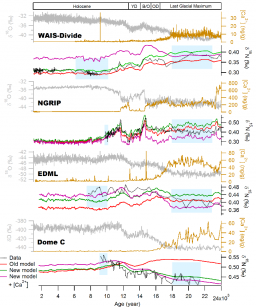
Figure: Comparison of the measured δ18O or δD (grey), the calcium concentration (gold), the measured δ15N (black) and the modelled δ15N (old (red), new version (green) and new version with impurity (purple)) of the LGGE model for WAIS-Divide, NGRIP, EDML and Dome C. Blue boxes for each sites indicate the periods over which the d15N average for the LGM and EH have been estimated for the calculation of the amplitude of the d15N change over the deglaciation.
Abstract: The transformation of snow into ice is a complex phenomenon which is difficult to model. Depending on surface temperature and accumulation rate, it may take several decades to millennia for air to be entrapped in ice. The air is thus always younger than the surrounding ice. The resulting gas-ice age difference is essential to document the phasing between CO2 and temperature changes especially during deglaciations. The air trapping depth can be inferred in the past using a firn densification model, or using δ15N of air measured in ice cores.
All firn densification models applied to deglaciations show a large disagreement with δ15N measurements in several sites of East Antarctica, predicting larger firn thickness during the Last Glacial Maximum, whereas δ15N suggests a reduced firn thickness compared to the Holocene. Here we present modifications of the LGGE firn densification model, which significantly reduce the model-data mismatch for the gas trapping depth evolution over the last deglaciation at coldest sites of East Antarctica while preserving the good agreement between measured and modelled modern firn density profiles. In particular, we introduce a dependency of the creep factor on temperature and impurities in the firn densification rate calculation. The temperature influence intends to reflect the dominance of different mechanisms for firn compaction at different temperatures. We show that both the new temperature parameterization and the influence of impurities contribute to the increased agreement between modelled and measured δ15N evolution during the last deglaciation at sites with low temperature and low accumulation rate, such as Dome C or Vostok. We find that a very low sensitivity of the densification rate to temperature has to be used in coldest conditions. unless threshold effects are taken into account.
C. Bréant, P. Martinerie, A. Orsi, L. Arnaud and A. Landais
Reference : Clim. Past, 13, 833-853, 2017, doi:10.5194/cp-13-833-2017






